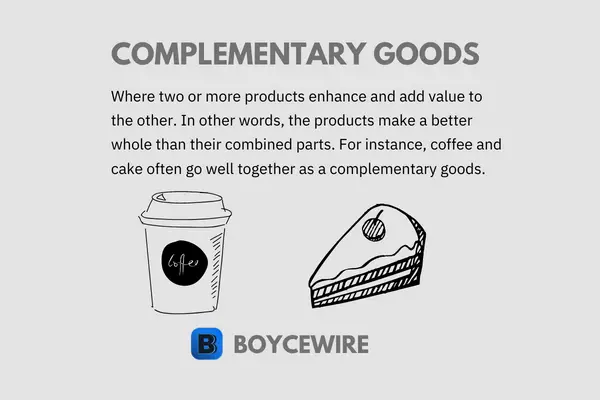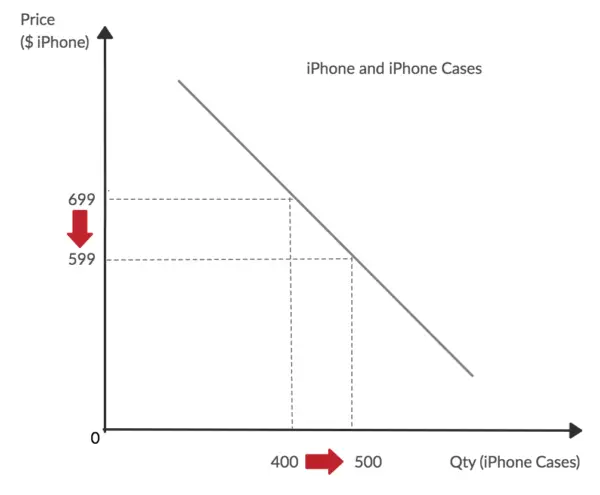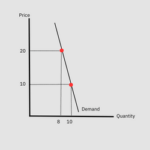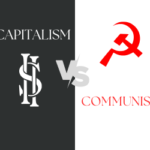Table of Contents ![]()
Complementary Goods: Definition & Examples

Complementary Goods Definition
A Complementary good is a product or service that adds value to another. In other words, they are two goods that the consumer uses together. For example, cereal and milk, or a DVD and a DVD player.
On occasion, the complementary good is absolutely necessary, as is the case with petrol and a car. However, a complementary good can add value to the initial product. For instance, pancakes and maple syrup.
Key Points
- A complementary good is a good that adds value to another, or, a good that cannot be used without each other.
- Complementary goods that cannot be used without each other are known to have a strong relationship. In other words, when the price goes up on one, the demand goes down for the other good.
- Examples include: Tennis Balls and Tennis Racket; PlayStations and Games; Movies and Popcorn; and Mobile Phones and Sim Cards.
Complementary Goods have a negative relationship with each other – which means that when product X increases in price, demand for product Y falls. This is because fewer people buy product X due to the higher price. As a result, fewer people are also buying product Y, which only adds value to product X. In economic jargon, this is known as ’negative cross-elasticity of demand’.
Let us consider an iPhone. If its price increases by 10 percent, this may lead to lower levels of demand. At the same time, if fewer people are buying iPhones, then there are also fewer people buying iPhone cases. It is because of this relationship that we can consider these as complementary goods.
Weak Complementary Goods
Not all complementary goods are the same. There are ‘weak’ and ‘strong’ complementary goods. Weak complementary goods respond to increases in prices in a very limited way. In other words, they are not responsive to increases in prices of complementary goods. However, there is some connection between the two.
If we take pancakes and maple syrup as an example – they are two complementary goods. Consumers use maple syrup with pancakes, but they also use other toppings. For instance, consumers may use bananas or sugar instead. Therefore, whilst maple syrup is used to complement pancakes, there are many other alternatives that make the relationship between the two weak.
If the price of maple syrup increases by 10 percent, but the demand for pancakes falls by 1 percent, the relationship is therefore weak. This is because the price increase of the complementary product has little effect on the demand on the other.
Strong Complementary Goods
Strong Complementary Goods have a close relationship with each other. That is to say that one good is reliant on the other to add value. For example, we have a DVD and a DVD player. These are known as strong complementary goods because they are pretty useless without one another.
The relationship between strong complementary goods is very elastic. In other words, when the price of DVD players rise, the demand for DVDs is likely to fall. So we can say there is a ‘negative cross-elasticity’ between them. In fact, if you look at any product that could not be sold by itself – it is likely a strong complementary good. So if you could only use Product X if you first had Product Y, then they are strong complementary goods.
Complementary Goods Graph
As we can see from the graph below; when the price of an iPhone decreases, the demand for iPhone cases increases. This is because the demand for iPhones increases as more consumers are buying it at the lower prices. In turn, those same consumers are demanding iPhone cases – which translates into high sales.

Complementary Goods Examples
Complementary goods are goods which rely on each other to add value. There are a large number of complementary goods which are necessary in order for the other to work. For example, petrol is needed for cars to work. However, there are also weak complementary goods that are not necessarily needed in order to function. An iPhone does not need a phone case in order to work, but is still classed as a complementary good. Other examples include:
- Tennis Balls and Tennis Racket
- Mobile Phones and Sim Cards
- Petrol and Cars
- Burger and Burger Buns
- PlayStation and Games
- Movies and Popcorn
- Shoes and Insoles
- Pencils and Notebooks
FAQs
A Complementary good can be a product or service that is sold separately that adds value to another. In other words, they are two or more goods that are used together.
Substitute goods are two goods that can be used in place of one another, for example, Dominos and Pizza Hut. By contrast, complementary goods are those that are used with each other. For example, pancakes and maple syrup.
The key difference is that substitute goods replace one another, whilst complementary goods add value to the other.
Some examples of complementary goods include:
1. Tennis Balls and Tennis Racket
2. Mobile Phones and Sim Cards
3. Petrol and Cars
4. Burger and Burger Buns
5. PlayStation and Games
6. Movies and Popcorn
7. Shoes and Insoles
8. Pencils and Notebooks
About Paul
Paul Boyce is an economics editor with over 10 years experience in the industry. Currently working as a consultant within the financial services sector, Paul is the CEO and chief editor of BoyceWire. He has written publications for FEE, the Mises Institute, and many others.

Further Reading
 Inelastic Demand: Definition & Examples - Inelastic demand is where the demand for a good does not significantly respond to changes in price.
Inelastic Demand: Definition & Examples - Inelastic demand is where the demand for a good does not significantly respond to changes in price.  Communism vs Capitalism - Capitalism is an economic system where the means of production are privately owned and operated for profit, while communism is…
Communism vs Capitalism - Capitalism is an economic system where the means of production are privately owned and operated for profit, while communism is…  Debentures - Debentures are long-term debt instruments issued by corporations or governments to raise funds, typically offering fixed interest payments and repayment…
Debentures - Debentures are long-term debt instruments issued by corporations or governments to raise funds, typically offering fixed interest payments and repayment… 